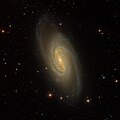NGC 2903
| Galaxie NGC 2903 | |
|---|---|
 | |
| Aufnahme mit dem 81-cm-Spiegelteleskop des Mount-Lemmon-Observatoriums. | |
| AladinLite | |
| Sternbild | Löwe |
| Position Äquinoktium: J2000.0, Epoche: J2000.0 | |
| Rektaszension | 09h 32m 10,11s[1] |
| Deklination | +21° 30′ 03,0″[1] |
| Erscheinungsbild | |
| Morphologischer Typ | SAB(rs)bc I-II / HII[1] |
| Helligkeit (visuell) | 8,8 mag[2] |
| Helligkeit (B-Band) | 9,6 mag[2] |
| Winkelausdehnung | 12,6′ × 6′[2] |
| Positionswinkel | 17°[2] |
| Flächenhelligkeit | 13,3 mag/arcmin²[2] |
| Physikalische Daten | |
| Zugehörigkeit | Isoliert[1] |
| Rotverschiebung | 0,001834 ± 0,000001[1] |
| Radialgeschwindigkeit | (550 ± 0) km/s[1] |
| Hubbledistanz H0 = 73 km/(s • Mpc) | (21 ± 1) · 106 Lj (6,43 ± 0,45) Mpc [1] |
| Durchmesser | 100.000 Lj[3] |
| Geschichte | |
| Entdeckung | Wilhelm Herschel |
| Entdeckungsdatum | 16. November 1784 |
| Katalogbezeichnungen | |
| NGC 2903 • NGC 2905 • UGC 5079 • PGC 27077 • CGCG 122-014 • MCG +04-23-009 • IRAS 09293+2143 • 2MASX J09321011+2130029 • GC 1861 • H I 56 • h 604 • HIPASS J0932+21 • KIG 347 • NVSS J093210+213010 | |
NGC 2903 ist eine Balken-Spiralgalaxie vom Hubble-Typ SBbc mit hoher Sternentstehungsrate im Sternbild Löwe an der Ekliptik. Die Galaxie ist rund 21 Millionen Lichtjahre von der Milchstraße entfernt und hat einen Durchmesser von 100.000 Lichtjahren.
Im selben Himmelsareal befinden sich unter anderem die Galaxien PGC 26951, PGC 27115, PGC 164868, PGC 1647510.[4]
Das Objekt wurde am 16. November 1784 von dem deutsch-britischen Astronomen Wilhelm Herschel entdeckt. Der Katalogeintrag NGC 2905 geht auf ein helles Gebiet in NGC 2903 zurück.[5]
- Detailaufnahme des zentralen Bereichs, Hubble-Weltraumteleskop
- Ultraviolett-Aufnahme von NGC 2903 mittels GALEX
Literatur
- König, Michael & Binnewies, Stefan (2019): Bildatlas der Galaxien: Die Astrophysik hinter den Astrofotografien, Stuttgart: Kosmos, S. 137
Weblinks
- SIMBAD Astronomical Database
- Barred Spiral Galaxy NGC 2903 – Astronomy Picture of the Day vom 21. März 2001 (englisch).
- Iconic (engl.)
- astronews.com: Details einer Balken-Spiralgalaxie 28. Februar 2001
- astronews.com: Bild des Tages 21. März 2013
- CDS Portal
- Hubble Experiences Déjà vu (engl.)
- Spektrum.de: Sammlung von Amateuraufnahmen
Einzelnachweise
Auf dieser Seite verwendete Medien
Autor/Urheber: (Credit) ESA/Hubble & NASA, L. Ho, J. Lee and the PHANGS-HST Team, Lizenz: CC BY 4.0
Hubble Experiences Déjà vu
This jewel-bright Picture of the Week features the spiral galaxy NGC 2903. This image was captured using Hubble’s Advanced Camera for Surveys (ACS) and Wide Field Camera 3 (WFC3), which were installed on Hubble in 2002 and 2009 respectively. Interestingly, Hubble has observed this particular galaxy before, in 2001, when neither the ACS or the WFC3 had yet been installed. The 2021 image boasts higher resolution, which means that NGC 2903 is more finely detailed than in the 2001 image. The ACS and WFC2 collectively cover a wide range of ultraviolet, optical and infrared wavelengths, which means that the 2021 image also has superior wavelength coverage to that of its 20-year-old predecessor. The 2001 image was taken using the Wide Field Planetary Camera 2 (WFPC2), which was Hubble’s workhorse instrument from 1993 until 2009 when it was replaced by the WFC3.
Hubble has a long and fascinating history of crewed service missions, which were performed in order to correct for imperfections in Hubble’s mirror, to update Hubble’s technical systems, and to remove old instruments and install new ones. One of Hubble’s most remarkable features is it’s incredible longevity, and this would not have been possible with the great success of the servicing missions. The juxtaposition of the 2001 and 2021 images of NGC 2903 — both remarkable images for their time — highlights the value of a stable, accessible platform in space that can reliably collect data, not only year after year, but decade after decade.
Credit:
ESA/Hubble & NASA, L. Ho, J. Lee and the PHANGS-HST Team
Coordinates Position (RA): 9 32 10.05 Position (Dec): 21° 29' 39.76" Field of view: 3.90 x 2.62 arcminutes Orientation: North is 295.8° right of vertical Colours & filters Band Wavelength Telescope Optical U 336 nm Hubble Space Telescope WFC3 Ultraviolet UV 275 nm Hubble Space Telescope WFC3 Optical B 438 nm Hubble Space Telescope WFC3 Optical V 555 nm Hubble Space Telescope WFC3 Optical I 814 nm Hubble Space Telescope WFC3 Optical N II 658 nm Hubble Space Telescope ACS.
NGC 2903 galaxy on GALEX sky survey
Autor/Urheber: Credit Line and Copyright Adam Block/Mount Lemmon SkyCenter/University of Arizona, Lizenz: CC BY-SA 3.0 us
NGC 2903
Picture Details:
Optics 32-inch Schulman RC Optical Systems Telescope Camera SBIG STx16803 CCD Camera Filters AstroDon Generation II Dates January and February 2015 Location Mount Lemmon SkyCenter Exposure LRGB = 9:3:3:3 Hours Acquisition Maxim DL/CCD (Cyanogen), AStronomer Control Panel (DC3- Dreams) Processing CCDStack (CCDWare), Photoshop CC, PixInsightCredit Line and Copyright Adam Block/Mount Lemmon SkyCenter/University of Arizona
Autor/Urheber: Sloan Digital Sky Survey, Lizenz: CC BY 4.0

Angle of view: 15' × 15' (0.45" per pixel), north is up.
Details on the image processing pipeline: https://www.sdss.org/dr14/imaging/jpg-images-on-skyserver/





